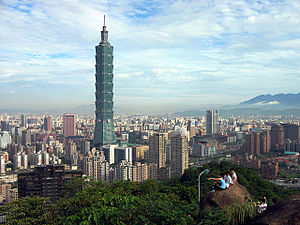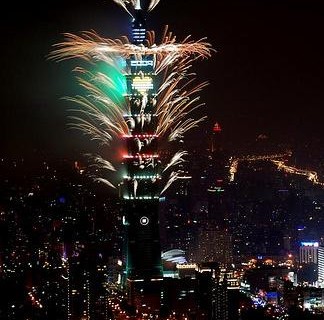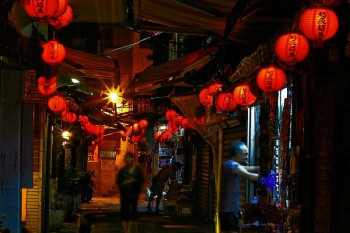Taipei 101 (Chinese: 臺北101 / 台北101) – stylized as TAIPEI 101[1] and formerly known as the Taipei World Financial Center – is a landmark supertall skyscraper in Xinyi District, Taipei,Republic of China. The building was officially classified as the world’s tallest in 2004, and remained such until the opening of Burj Khalifa in Dubai in 2010. In 2011, the building was awarded the LEED platinum certification, the highest award according to the Leadership in Energy and Environmental Design (LEED) rating system, and became the tallest and largest green building in the world.[9][10]
Taipei 101 was designed by C.Y. Lee and Partners and was constructed by Samsung C&T and KTRT Joint Venture .[5][6] Construction on the 101-story tower started in 1999 and finished in 2004. The tower has served as an icon of modern Taiwan ever since its opening. The building was architecturally created as a symbol of the evolution of technology and Asian tradition. Itspostmodernist approach to style incorporates traditional design elements and gives them modern treatments. The tower is designed to withstand typhoons and earthquakes. A multi-level shopping mall adjoining the tower houses hundreds of stores, restaurants and clubs. Fireworks launched from Taipei 101 feature prominently in international New Year’s Eve broadcasts and the structure appears frequently in travel literature and international media.
Taipei 101 is primarily owned by Ting Hsin International Group. Urban Retail Properties is responsible for property management and leasing. The name originally planned for the building, Taipei World Financial Center, until 2003, was derived from the name of the owner. The original name in Chinese was literally Taipei International Financial Center (Chinese: 臺北國際金融中心).
Contents
[hide]
Features[edit]
Height[edit]
Taipei 101 comprises 101 floors above ground, as well as 5 basement levels. It was not only the first building in the world to break the half-kilometer mark in height,[3] but also the world’s tallest building from March 2004 to 10 March 2010[11][12] As of 28 July 2011, it is still the world’s largest and highest-use green building.[9][10]
Upon its completion, Taipei 101 was the world’s tallest inhabited building, at 509.2 m (1,671 ft) as measured to its height architectural top (spire), exceeding the Petronas Towers, which were previously the tallest inhabited skyscraper at 451.9 m (1,483 ft). The height to the top of the roof, at 449.2 m (1,474 ft), and highest occupied floor, at 439.2 m (1,441 ft), surpassed the previous records of 442 m (1,450 ft) and 412.4 m (1,353 ft), respectively; the Willis Tower had previously held that distinction.[3][13][14][15][16] It also surpassed the 85-story, 347.5 m (1,140 ft)Tuntex Sky Tower in Kaohsiung as the tallest building in Taiwan and the 51-story, 244.15 m (801 ft) Shin Kong Life Tower as the tallest building in Taipei.[17][18] Taipei 101 claimed the official records for the world’s tallest sundial and the world’s largest New Year’s Eve countdown clock.[19]
Various sources, including the building’s owners, give the height of Taipei 101 as 508 m (1,667 ft), roof height and top floor height as 448 m (1,470 ft) and 438 m (1,437 ft). This lower figure is derived by measuring from the top of a 1.2 m (4 ft) platform at the base.[1][3] CTBUH standards, though, include the height of the platform in calculating the overall height, as it represents part of the man-made structure and is above the level of the surrounding pavement.[13][15][14][16] Taipei 101 displaced the Petronas Towers as the tallest building in the world by 57.3 m (188 ft).[15][20] The record it claimed for greatest height from ground to pinnacle was surpassed by the Burj Khalifa in Dubai, which is 829.8 m (2,722 ft) in height. Taipei 101’s records for roof height and highest occupied floor briefly passed to the Shanghai World Financial Center in 2008, which in turn yielded these records as well to the Burj.[13][15]
Visited 1270 times, 1 Visit today






